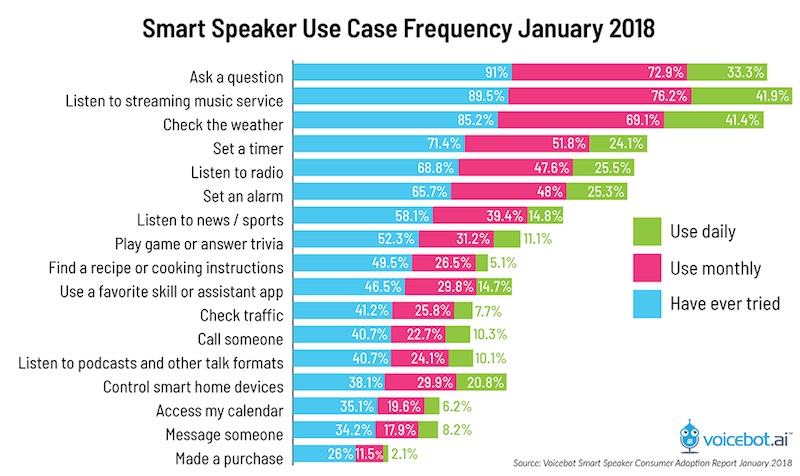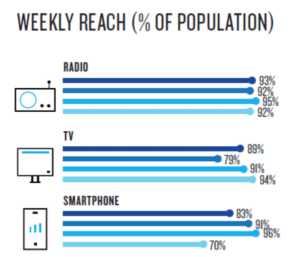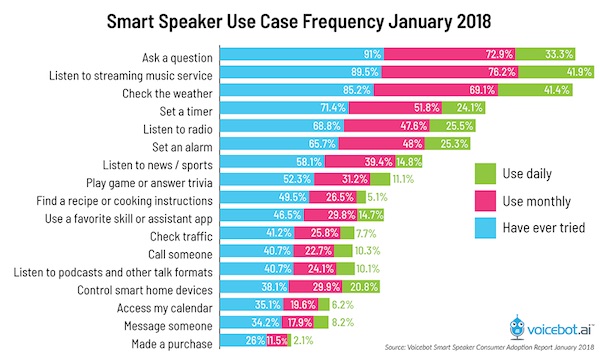Data Breakdown, How Consumers Use Smart Speakers Today
One of the core objectives of the Smart Speaker Consumer Adoption Report 2018 was to determine what use cases consumers had tried on the devices and how frequently they were employed. Voicebot, RAIN Agency and PullString identified 17 consumer use cases and asked over 1,000 consumers about their smart speaker experience. What did we find? Consumers are not just trying out their smart speakers, they are using them regularly. Seventy percent of smart speaker owners use them at least weekly and 86% at least monthly. Habits are clearly being formed.

Entertainment, Information and Time-Based Alerts Top the List
Listening to audio content such as music, news, sports or a radio station hold three of the top seven spots for “ever tried” and monthly active users. News and sports does fall to eighth place for daily use, getting nudged out by smart home use cases. General information questions are tried by 91% of smart speakers owners. That is the top overall response. However, it does fall behind music listening and asking for the weather when it comes to frequency of use.

Source: Nielsen 2017
Then there are timers and alarms. Time and alerting are a staple of modern society. We have these capabilities throughout the home in appliances, listening devices and smartphones. However, consumers apparently like using their smart speaker voice assistants for these tasks as 52% claim to use timers at least monthly and 48% report doing the same for alarms.
Radio appears to have much more growth potential on smart speakers. Thirty-nine percent of smart speaker owners report listening at least weekly to radio on the devices. That represents about 5.4% of the total U.S. adult population. Nielsen reports that 93% of Americans listen to radio weekly. This reach indicates both consumer familiarity and interest in radio. We know that a large percentage of radio listening today takes place in the car. Smart speakers could help extend those listening sessions back into the home as awareness of radio options through voice assistants become more widely known. Radio doesn’t need to recruit new listeners. It just needs existing listeners to start listening through smart speakers to grow its share of use.
Following a Familiar Pattern
Michael Fitzpatrick, COO and president of PullString noticed a pattern in the consumer smart speaker responses that reminded him of the early days of mobile.
News and music are dominating user activity on smart speakers, just as they did in the early days of mobile devices a decade ago. We believe the emergence of gaming, communication, and commerce on these voice platform will accelerate adoption just as they did for mobile.
Smart speaker owner use of games was another interesting finding from the report. This has been a big focus for Amazon and was the first Alexa skill segment to offer developer rewards for building popular skills. More than half of smart speaker owners report at least trying a game on their device and nearly one-third say they use them monthly.
Communication features are used less frequently, but it is interesting that about 10% of device owners claim to use these daily. Forty-one percent of smart speaker owners report having used their device to make a phone call and 34% have used messaging. In both cases, monthly use is about half of those that have tried the feature. However, it is the daily and weekly metrics that stand out and should be monitored for growth.
Finally, voice commerce adoption was surprising. More than one-in-four smart speaker owners say they have purchased something using voice and 11.5% say they are using the feature monthly. Smart speakers offer a very simple value proposition of convenience. Consumers can already access the features elsewhere, but smart speakers make that access more convenient. Several analysts were skeptical that using smart speakers for purchasing would be viewed as convenient because you cannot see the purchase process or product details before checking out. It turns out that consumers are familiar enough with shopping online that viewing the purchase process steps is unnecessary.
If you would like to reach more about consumer use cases on smart speakers, the entire report can be downloaded here.
Voice Shopping is Monthly Habit for 11.5% of Smart Speaker Owners
New Voicebot Report Says Nearly 20% of U.S. Adults Have Smart Speakers









